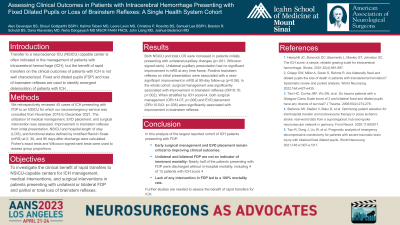Assessing Clinical Outcomes in Patients with Intracerebral Hemorrhage Presenting with Fixed Dilated Pupils or Loss of Brainstem Reflexes: A Single Health System Cohort
Friday, April 21, 2023


Alex Devarajan (he/him/his)
Medical Student
Icahn School of Medicine at Mount Sinai
New York, New York, United States
ePoster Presenter(s)
Introduction: Transfer to a neuroscience ICU (NSICU) capable center is often indicated in the management of patients with intracerebral hemorrhage (ICH), but the benefit of rapid transfers on the clinical outcomes of patients with ICH is not well characterized. Fixed and dilated pupils (FDP) and loss of brainstem reflexes are used to identify emergent deterioration of patients with ICH. This study aimed to investigate the clinical benefit of rapid transfers to NSICU-capable centers for ICH management, medical interventions, and surgical interventions in patients presenting with unilateral or bilateral FDP and partial or total loss of brainstem reflexes.
Methods: We retrospectively reviewed 45 cases of ICH presenting with FDP to an NSICU for which our neuroemergency service was consulted from November 2018 to December 2021. The utilization of medical management, EVD placement, and surgical intervention was assessed. Improvement in brainstem reflexes from initial presentation, NSICU and hospital length of stay (LOS), and functional status defined by modified Rankin Scale (mRS) at 0, 30, and 90 days after discharge were calculated. Fisher’s exact tests and Wilcoxon signed-rank tests were used to assess group proportions.
Results: Both NSICU and total LOS were increased in patients initially presenting with unilateral pupillary changes (p < .001, Wilcoxon signed-rank). Unilateral pupillary presentation had no significant improvement in mRS at any time frame. Positive brainstem reflexes on initial presentation were associated with a near-significant improvement in mRS at 90-day follow-up (p=0.06). In the whole cohort, surgical management was significantly associated with improvement in brainstem reflexes (OR=8.10;p=.002). When stratified by ICH score>4, both surgical management (OR=14.07;p=.008) and EVD placement (OR=10.543;p=.036) were significantly associated with improvement in brainstem reflexes.
Conclusion : Early surgical management and EVD placement remain critical to improving clinical outcomes in patients with ICH. Further studies are needed to assess the benefit of rapid transfers for ICH.
Methods: We retrospectively reviewed 45 cases of ICH presenting with FDP to an NSICU for which our neuroemergency service was consulted from November 2018 to December 2021. The utilization of medical management, EVD placement, and surgical intervention was assessed. Improvement in brainstem reflexes from initial presentation, NSICU and hospital length of stay (LOS), and functional status defined by modified Rankin Scale (mRS) at 0, 30, and 90 days after discharge were calculated. Fisher’s exact tests and Wilcoxon signed-rank tests were used to assess group proportions.
Results: Both NSICU and total LOS were increased in patients initially presenting with unilateral pupillary changes (p < .001, Wilcoxon signed-rank). Unilateral pupillary presentation had no significant improvement in mRS at any time frame. Positive brainstem reflexes on initial presentation were associated with a near-significant improvement in mRS at 90-day follow-up (p=0.06). In the whole cohort, surgical management was significantly associated with improvement in brainstem reflexes (OR=8.10;p=.002). When stratified by ICH score>4, both surgical management (OR=14.07;p=.008) and EVD placement (OR=10.543;p=.036) were significantly associated with improvement in brainstem reflexes.
Conclusion : Early surgical management and EVD placement remain critical to improving clinical outcomes in patients with ICH. Further studies are needed to assess the benefit of rapid transfers for ICH.
